You have no items in your shopping cart.
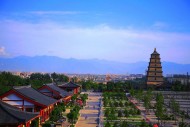

Introducing Big Wild Goose Pagoda
The Big Wild Goose Pagoda was built by the Buddhist monk Xuanzang. Xuanzang is one of the greatest ancient Chinese travelers, scholars and translators. For Chinese, his name is as famous as Marco Polo for Westerners. During the early Tang Dynasty, between 629 and 645, Xuanzang journeyed to India and visited over one hundred kingdoms, and wrote extensive and detailed reports of his findings. During his travels he learned the lore of his faith, and studied with many famous Buddhist masters, especially at the famous center of Buddhist learning at Nalanda University in India. Authored the Great Tang Records on the Western Regions, his seventeen-year overland journey to India is recorded in detail. The Chinese novel Journey to the West, one of the Four Great Classical Novels of Chinese literatures, is inspired by his autobiography. On his return to China in 645, Xuanzang was greeted with great honor but he refused all high civil appointments offered by Emperor Taizong. Instead, he retired to a monastery and devoted his energy to translating Buddhist texts. In 648, Daci'en Temple was built by Crown Prince Li Zhi in commemoration of his mother Empress Zhangsun. Xuanzang was invited by Crown Prince Li Zhi to be the Abbot of this temple. Xuanzang set up a large translation bureau in Daci'en Temple, drawing students from all over East Asia. With the support of Emperor Gaozong, Xuanzang built this 64 meter high Big Wild Goose Pagoda in 652 to house the 657 Sanskrit texts, seven statues of the Buddha and 150 Sarira relics that he brought from India. Daci'en temple is arranged on a south-north axis, and contains four main buildings. Beginning at the south is the main gate followed by the Mahavira Hall, Tusita Palace, the Big Wild Goose Pagoda and Xuanzang Sanzang Hall. The Big Wild Goose Pagoda was listed as UNESCO World Heritages Site under "Silk Roads: the Routes Network of Chang'an-Tianshan Corridor" in 2014.
Watch this video showcasing Big Wild Goose Pagoda
Kind Notice: You can not watch this video if you are in China (YouTube is blocked in China).
Big Wild Goose Pagoda Fast Facts
• Chinese Name: Da Yan Ta 大雁塔
• Best Time to Visit: All year round
• Recommended Visiting Hours: About 2-3 hours
• Things to Do: Photography, Buddhist Study
• Opening Hours: 8:00 - 18:00
• Entrance Fee: ¥40/person for Da Ci’en Temple; extra ¥25/person for ascending the pagoda
• Address: Daci’en Temple, Yanta South Road, Xi’an, Shaanxi Province
What to expect at Big Wild Goose Pagoda
Daci'en Temple
The name of Daci'en Temple is a story of mourning and filial piety, a concept held in high-esteem in Chinese culture. Daci'en Temple rests on the site of Wulou Temple or Five Storey Temple built in 589 during the Sui Dynasty. Over the years this temple fell into disrepair. In 648 during the Tang Dynasty, the Crown Prince Li Zhi spearheaded the renovation of the temple in honour of his mother, the Empress Zhangsun, who had tragically suffered an early death. Crown Prince Li Zhi wanted to pay tribute to his mother’s kindness and so named the temple Daci'en, which means kindness and grace in Chinese. The temple originally had 13 separate courtyards and 1,879 rooms, all of them unmatched in their grandeur, but tragically the temple once again fell into disrepair after the fall of the Tang Dynasty in 907. The temple was renovated during the Ming Dynasty (1367 - 1644) and the surviving halls and rooms were all built during the Ming Dynasty. The size of current Daci'en Temple is only one seventh of that of the Tang Dynasty Daci'en Temple.
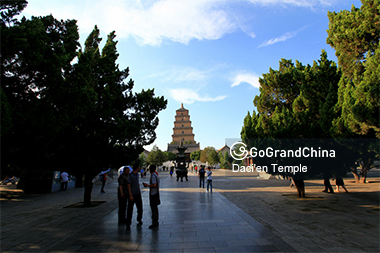
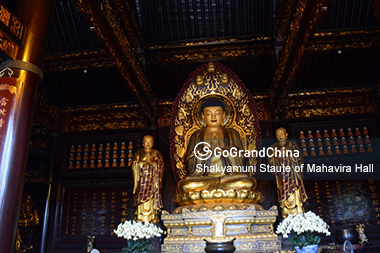
Mahavira Hall
The Mahavira Hall is the main hall of a Buddhist temple. It is also known as the Precious Hall of the Great Hero. It serves as the core architecture of the whole temple and also a place for monks to practice. The statue of Shakyamuni, the founder of Buddhism is enshrined in the center of the hall. The Shakyamuni Buddha is represented in an attitude of contemplation, sitting on lotus flower; two disciples' statues are placed on his right and left, the older is called Kashyapa and the young-looking figure is called Ananda. On the east and west sides of the hall are arranged eighteen figures of Arhans. They listen to Buddha, some with thoughtfulness, some with pleasure.
Tushita Palace
Tushita is the fourth of the six heavens in the world of desire according to Buddhism. It is said that bodhisattvas are reborn in this heaven just before their rebirth in the world where they will attain Buddhahood. Shakyamuni is said to have descended from this heaven and entered the womb of his mother, Maya. Tushita consists of an inner court and an outer court. The inner court is the abode of Bodhisattva Maitreya, who is constantly preaching until his future rebirth in the human world as a Buddha. Tusihta Heaven is where all Bodhisattvas destined to reach full enlightenment in their next life dwell. Many Buddhists vow to be reborn in Tushita so that they can hear the teachings of Maitreya and ultimately be reborn with him when he becomes a Buddha. A bronze Maitreya Buddha image, 2.7 meter high, is enshrined in the middle of this Tushita Palace.
Big Wild Goose Pagoda
Here are some fast facts on the Big Wild Goose Pagoda. This pagoda was built in 652. It was built by Xuanzang. It is seven storeys, 64 meters high. It was built to house the 657 Sanskrit texts, seven statues of the Buddha and 150 Sarira relics brought to China from India by Xuanzang. The current pagoda is a leaning tower, leaning somewhat one meter to the northwest. Xuanzang named this pagoda Big Wild Goose Pagoda for the reason that he visited a pagoda with the same name in India, The Indian pagoda's name comes from a famous Buddhist history. Once upon a time, there were two branches of Buddhism in India, for one of which eating meat was not a taboo. One day, the monks couldn’t find meat to eat. Upon seeing a group of big wild geese flying by, a monk said to himself: “Today we have no meat. I hope the merciful Buddha will give us some.” At that very moment, the leading wild goose broke its wings and fell to the ground. All the monks were startled and believed that this was a warning from Buddha, prompting them to be more pious and less fixated on worldly pleasures, and so they stopped eating meat. A pagoda was supposedly built on the spot where the famed wild goose fell and the pagoda was named Big Wild Goose Pagoda.
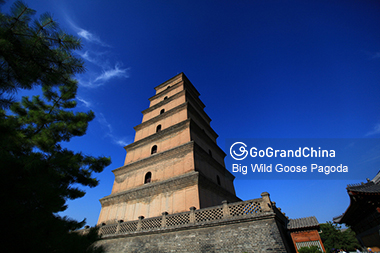
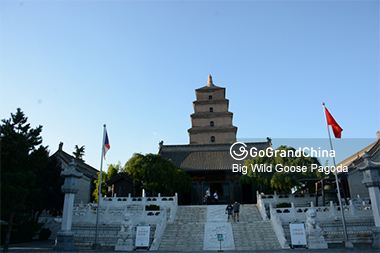
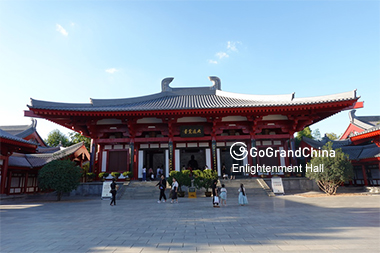
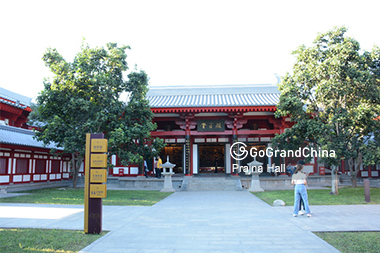
Enlightenment Hall
The central courtyard of Xuanzang Sanzang Hall is named Enlightenment Hall (Dabianjue Hall in Chinese). A bronze statue of Xuanzang is enshrined in the center of this hall. The Sarira of Xuanzang’s parietal bone is housed in a tiny gold gilded stupda in front of Xuanzang’s bronze statue. After the death of Xuanzang, Emperor Gaozong gave him a posthumous title, Dabianjue, meaning Complete Enlightenment. Xuanzang would have reached Tushita and become a Bodhisattva after his death. Frescoes on the walls of this hall depict the stories of Maitreya Buddha, his past, present and future. Some of the original palm-leaf manuscripts brought from India by Xuanzang are stored in the basement of this building.
Light Hall
The courtyard located to the west of Enlightenment Hall is named Light Hall. Frescoes on the wall of this hall depict the first half of Xuanzang’s life, from his birth to his conversion to Buddhism, the 17 year hard journey from China to India, his experience of studying Buddhism in India and his great achievements in Buddhism.
Prajna Hall
The courtyard located to the east of Enlightenment Hall is named Prajna Hall. Frescoes on the wall of this hall depict the life of Xuanzang from his return to China, the translation of Buddhist sutras from Sanskrit into Chinese, the founding of Yogacara School, to his death in 664.
Pagoda Forest
Pagoda Forest is the tomb area of Daci’en Temple. These pagodas were built to commemorate the eminence and contributions of prestigious and respectable Abbots of Daci’en Temple. After their death and cremation, the ashes would be put underground and a pagoda would be erected on the spot. The size, height and storeys of the pagoda indicate the accomplishments, prestige, merits and virtues of the abbot.
North Square of Big Wild Goose Pagoda
There are many featured squares and gardens around the Big Wild Goose Pagoda. The most remarkable one should be the North Square which is the largest musical fountain square in Asia. You can see the 2 group sculptures of 100m long, 8 large figure sculptures and 40 landscape sculptures, while appreciate the grand colorful fountain show dancing with the music.
Timetable of the Musical Fountain on the North Square: Tuesday (19:00, 21:00), other days (12:00,16:00, 19:00, 21:00).
How to get to Big Wild Goose Pagoda
By Bus
Take bus No. 5, 19, 21, 22, 23, 24, 27, 30, 34, 41, 44, 189, 224, 242, 271, 307, 400, 401, 408, 500, 521, 526, 527, 601, 606, 609, 701, Qujiang Tourist Bus, Huan Shan Tour Bus No. 1 & 2, Tourist Bus Line 6 & 8 (610) & 9(320), and get off at Dayanta Station.
By Metro: Take Metro Line 3 & 4 to Dayanta Station.
Additional travel advice on Big Wild Goose Pagoda
• Please watch out the steps while ascending the pagoda.
• The squares of Big Wild Goose Pagoda are always crowded with tourists during busy season. It is suggested to go to the north square in advance, if you want to appreciate the night view of the music fountain.
Tour Highlights
• Marvel at the proudly unflinching, life-sized Terracotta Warriors, considered the eighth wonder of the world.
• Visit Emperor Qin's Mausoleum, the final resting place of the first emperor of China, Qin Shihuang.
• Stroll along Xian City Wall, one of the oldest and best-preserved Chinese city walls in the world.
• Visit Big Wild Goose Pagoda, one of China’s best examples of Tang Dynasty style pagoda completed in AD652.
• Experienced English speaking tour guide.
• Overland round-trip transfers with private chauffeur and in-transport refreshments.
About This Tour
• Departure: Daily departing from Xian.
• Tour Duration: Approximately 8 hours.
• Pick-up Time: Between 07:00 and 10:00, choose a departure time most suitable for you.
• Pick-up & Drop-off Place: Your accommodation in Xian
• Advice on Meals: Lunch is not included in this tour. However, your guide can suggest local food options. We recommend having a substantial breakfast and bringing snacks to tide you over during sightseeing.
Tour Itinerary at a Glance
• Pick up from your accommodation in Xian
• Transfer to Terracotta Warriors (1 hour)
• Visit Terracotta Warriors & Emperor Qin's Mausoleum (2 & half hours)
• Transfer to City Wall of Xian (1 hour)
• Visit City Wall of Xian (30 minutes)
• Transfer to Big Wild Goose Pagoda (30 minutes)
• Visit Big Wild Goose Pagoda and Daci'en Temple (1 hour)
• Transfer back to your accommodation in Xian
Tailor This Tour to Meet Your Needs and Requirements
• If you want to modify this itinerary, please feel free to contact GoGrandChina by WhatsApp (+86-18309280878), Wechat (+86-18309280878) or email (info@GrandChinaTravel.com), we will create a tailor-made tour package for you.
Tour Prices (US$ Per Person)
| 1 person | 2 people | 3 people | 4 people | 5 people | 6 people | 7 people | 8 people | 9 people | 10 + |
| $248 | $158 | $128 | $108 | $98 | $92 | $88 | $86 | $82 | $78 |
Price Remarks
• Prices are not valid during China's Official Holidays (such as National Day & Chinese New Year Festival etc.).
Price Inclusions
• Professional English language speaking private tour guide
• Air-conditioned vehicle with private experienced driver
• All admission tickets to sightseeing places
• All government taxes
Price Exclusions
• Hotel accommodation.
• Your personal expenses.
• Meals are excluded allowing you flexibility on menu.
• Travel insurance is not included. Please purchase before your trip to provide for any unforeseen circumstances.
• Gratuities to guide & driver. They are customary and would be of great encouragement and reward for quality service.
Additional Info
• Confirmation will be received at time of booking.
• Operates in all weather conditions, please dress appropriately.
• The itinerary is subject to change due to traffic conditions or bad weather.
• The itinerary is flexible; changes can be made upon written request from travelers.
• IMPORTANT: It is required by the government regulations that travelers must provide their name, gender, nationality, passport number and date of birth to their tour operator upon booking a tour. Failure to do so could result in being denied access or admittance to sites and attractions during sightseeing. When you book this tour, please complete all required fields at checkout. Please bring your passport with you on the tour.
Cancellation Policy
• You may cancel the booking and receive a full refund up to 24 hours prior to the date of your tour.
• Cancellation within 24 hours or after the tour begins is non-refundable.
• Cancellation request will be confirmed in 2-5 business days, you will receive your refund within 14 working days.
Why Travelers Have to Choose GoGrandChina Private Tours?
• Choose your most suitable departure time, whether you are an early bird or you prefer sleeping in.
• GGC private tours are more flexible, allowing you to adjust everything on your trip to your wishes.
• GGC tour guides will be at your service to make sure you get the most from each destination. They are there for you and are responsible for making your journey special – and your needs always come first.
• GGC offers comfortable and luxury vehicles with a private & experienced driver who’s always by your side and ready to take you to your next destination.
• No shopping stops & factory visits, no chance of getting ripped off.
• No hidden costs, rest assured that there are no nasty surprises.